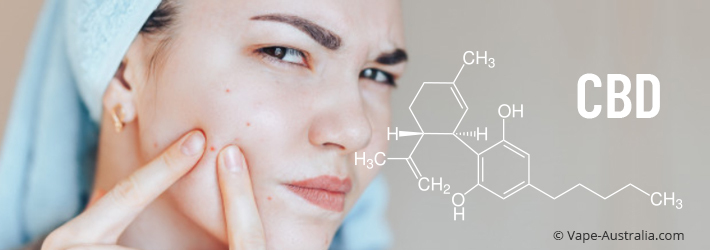
It may feel counterintuitive to apply oil on a face that’s sporting a full break out of acne. After all, we’ve been taught that acne is caused by oily, unclean skin. While that’s mostly a myth, the overproduction of sebum (oil) is usually the culprit that’s clogging the pores, trapping the bacteria, and causing the infection.
That’s why the standard recommendation for acne is to wash your face regularly and use oil-free makeup and products that are formulated for your skin type. People with dry or combination skin can get acne, too! However, if your skin is inflamed or creating too much sebum all of the time, then you’re likely to still end up with acne despite your best efforts.
Where Acne Comes From?
Acne’s not that simple, unfortunately. If you understand how acne is caused then you could have a better idea if CBD could possibly work for you.
Acne is usually caused by pores becoming blocked by oil and then becoming infected. Whether or not that pore remains open or closed can mean the difference between a whitehead (closed) or a blackhead (open). What actually causes this varies.
- Hormonal fluctuations: whether this is from puberty or menstrual cycles, hormones can increase sebum or skin cell growth, causing the blockage of acne.
- Sweating and tight clothing: These can create blocked pores that become infected.
- Over and under washing: Finding your skin’s goldilocks is important because either over-washing or under-washing your skin can affect the production and buildup of oils and bacteria on the skin. There is no evidence to show that a regular, dirty face will inherently cause acne.
- Pimple popping: Some people love it. Some people hate it. You shouldn’t do it. You can’t always get to the root cause of the infection, and you’ll likely end up just pushing it deeper into the skin, eventually making it worse or cause scarring.
So, How Does CBD Work?
That’s where CBD comes in. Full-spectrum CBD—also known as cannabinoids—are a system of cannabinoids that trigger your endocannabinoid system to increase the production of natural cannabinoids that will attach to your endocannabinoid receptors.
In short: CBD makes your body create its own natural CBD. This endocannabinoid system influences things like pain response, inflammation, mood, memory, etc. There are endocannabinoid receptors in your skin, so if you were to apply CBD directly to the skin, then you could see targeted results.
Scientists are aware of the possible links and benefits to skincare, and they’re exploring this fully. Unfortunately, there are not enough studies on humans yet to state exactly how CBD could affect the skin and the variety of skin conditions. But, preliminary studies are promising.
A study suggests that CBD can help your body regulate its sebum production, among a variety of other things. This regulation of sebum production can mean so many things for the health and vitality of your skin.
The Journal of Dermatological Science released an article discussing the possible evidence that CBD can also inhibit the proliferation of certain skin cells, which leads to skin conditions like psoriasis and dry skin.
And the final piece to the puzzle: there is some evidence that CBD could have antibacterial and antifungal properties. Infections are what causes the acne and inflammation, so it’s possible that you could apply CBD to remove the bacteria and the root cause of the acne.
Add to the mix that CBD could have anti-inflammatory properties then you’ve got a good system that indicates that CBD could be a good addition to your skincare routine and acne treatment. It could be worth a shot. So, how do you purchase the right kind of CBD for your skin?
Choosing Acne CBD Products
Choosing the right CBD product to help your acne is very similar to the regular rules for acne products. But, if you want CBD to be an active ingredient, you should check a few things.
- Verify that the CBD is full-spectrum CBD. It’s more likely to be effective than isolated CBD.
- Check that the party has a third-party lab test on the products to ensure that you’re receiving true CBD and the advertised dosage.
- The amount of CBD in the bottle should be 300mg or higher per 2oz of product for any effects—any lower amounts and you may not see any results.
- Make sure that the product contains CBD and not hemp seed oil. While some companies may call their product “hemp oil” for legal purposes, ensure that it’s not hemp seed oil. Hemp seed oil does not contain cannabinoids, despite being a hydrating product.
After you’ve picked a high-quality CBD product, then you need to check the product like any other kind of skincare product. If you are known to be sensitive to certain ingredients, look for those, and look for the standard ingredients you should avoid (like denatured alcohol). If you’ve got sensitive skin, then also check for fragrances and the like, as these could be irritating.
Otherwise, the product could contain other helpful and moisturizing ingredients like vitamin C or others. Make sure to do your research on the ingredients and what you’re using on the skin, or you could make the acne go away!
The third (and perhaps least favorite) option is to add CBD to your existing skincare products. Some companies will sell 100% CBD extract, and you could add this to your existing regimen. This could work, but it would be difficult to get the correct dosages and it would not be formulated specifically for the skin or topical use.
How to Use CBD for Acne?
First, always follow the instructions on the bottle for how to apply the product. However, if you’re struggling with acne, make sure your skin is fresh and clean before applying any other kind of product.
When you do apply the product, make sure to apply it with a clean cotton pad or ball. This is to make sure you’re not adding bacterial or oil from your fingertips and avoiding any possible cause of acne.
And finally—make sure to let the CBD product sit on the skin for at least 10 minutes before compromising it (by washing, sweating, swimming, etc.). That’s about how long it takes for maximum absorption into your skin!
